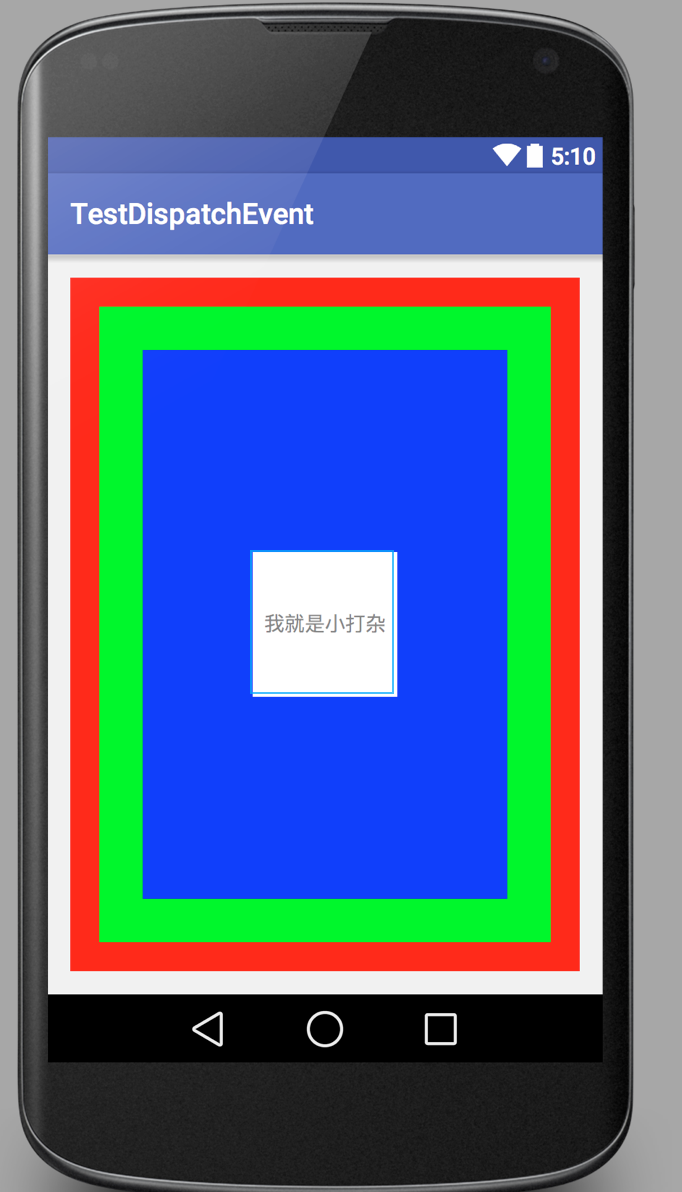网上很多用源码来分析touch事件机制的文章,但是由于View和ViewGroup事件分发和android系统事件分开有关系,所以看起来有点云里雾里的,下面自己写了一个例子来说嘛touch分发的原理,和我们工作中遇到此类问题应该怎么处理这类事件,首先必须知道的一点是ViewGroup是继承至ViewG的,这个你们可以去源码中看看,接下来我们来说明ViewGroup和View下的三个相关Touch分发的函数
- dispatchTouchEvent(): 该方法用于touch事件的分发, view和viewgroup都实现了该方法
- onTouchEvent(): 该方法就是用于具体的touch事件处理,这个方法实现在View中。
- onInterceptTouchEvent(): 该方法用于拦截touch事件,这个方法只有ViewGroup有。
接下来我们先看看源码中的官方说明:
/**
* Pass the touch screen motion event down to the target view, or this
* view if it is the target.
*
* @param event The motion event to be dispatched.
* @return True if the event was handled by the view, false otherwise.
*/
public boolean dispatchTouchEvent(MotionEvent event) {
}
上面写的很清楚,分发事件到对应的view,这是View源码中的类,实际ViewGroup中的更复杂,他多了一个功能就是还要往子View分发事件。
/**
* Implement this method to handle touch screen motion events.
* <p>
* If this method is used to detect click actions, it is recommended that
* the actions be performed by implementing and calling
* {@link #performClick()}. This will ensure consistent system behavior,
* including:
* <ul>
* <li>obeying click sound preferences
* <li>dispatching OnClickListener calls
* <li>handling {@link AccessibilityNodeInfo#ACTION_CLICK ACTION_CLICK} when
* accessibility features are enabled
* </ul>
*
* @param event The motion event.
* @return True if the event was handled, false otherwise.
*/
public boolean onTouchEvent(MotionEvent event) {
}
上面这个方法就是我们经常用到的,具体对touch事件的处理。
/**
* Implement this method to intercept all touch screen motion events. This
* allows you to watch events as they are dispatched to your children, and
* take ownership of the current gesture at any point.
*
* <p>Using this function takes some care, as it has a fairly complicated
* interaction with {@link View#onTouchEvent(MotionEvent)
* View.onTouchEvent(MotionEvent)}, and using it requires implementing
* that method as well as this one in the correct way. Events will be
* received in the following order:
*
* <ol>
* <li> You will receive the down event here.
* <li> The down event will be handled either by a child of this view
* group, or given to your own onTouchEvent() method to handle; this means
* you should implement onTouchEvent() to return true, so you will
* continue to see the rest of the gesture (instead of looking for
* a parent view to handle it). Also, by returning true from
* onTouchEvent(), you will not receive any following
* events in onInterceptTouchEvent() and all touch processing must
* happen in onTouchEvent() like normal.
* <li> For as long as you return false from this function, each following
* event (up to and including the final up) will be delivered first here
* and then to the target's onTouchEvent().
* <li> If you return true from here, you will not receive any
* following events: the target view will receive the same event but
* with the action {@link MotionEvent#ACTION_CANCEL}, and all further
* events will be delivered to your onTouchEvent() method and no longer
* appear here.
* </ol>
*
* @param ev The motion event being dispatched down the hierarchy.
* @return Return true to steal motion events from the children and have
* them dispatched to this ViewGroup through onTouchEvent().
* The current target will receive an ACTION_CANCEL event, and no further
* messages will be delivered here.
*/
public boolean onInterceptTouchEvent(MotionEvent ev) {
return false;
}
上面这个函数可以看看应该,这个函数是用来拦截touch事件的,默认返回的是false,如果返回true,当前的View的dispatchTouchEvent()和onTouchEvent()还会运行,但是子View的相关函数将不再运行。
下面我用一个例子来说明这个问题,我建立了一个工程,自定义了三个MyLinearLayout,MyLinearLayout1,MyLinearLayout2类继承至LinearLayout,同样的代码如下,但是有三个:
public class MyLinearLayout extends LinearLayout {
public MyLinearLayout(Context context) {
super(context);
}
public MyLinearLayout(Context context, AttributeSet attrs) {
super(context, attrs);
}
public MyLinearLayout(Context context, AttributeSet attrs, int defStyleAttr) {
super(context, attrs, defStyleAttr);
}
@Override
public boolean onInterceptTouchEvent(MotionEvent ev) {
Log.d("MyLinearLayout", "onInterceptTouchEvent");
return super.onInterceptTouchEvent(ev);
}
@Override
public boolean dispatchTouchEvent(MotionEvent ev) {
Log.d("MyLinearLayout", "dispatchTouchEvent");
return super.dispatchTouchEvent(ev);
}
@Override
public boolean onTouchEvent(MotionEvent event) {
Log.d("MyLinearLayout", "onTouchEvent");
return super.onTouchEvent(event);
}
}
还写了一个MyTextView类,继承于TextView,代码如下:
public class MyTestView extends TextView {
public MyTestView(Context context) {
super(context);
}
public MyTestView(Context context, AttributeSet attrs) {
super(context, attrs);
}
public MyTestView(Context context, AttributeSet attrs, int defStyleAttr) {
super(context, attrs, defStyleAttr);
}
@Override
public boolean dispatchTouchEvent(MotionEvent event) {
Log.d("MyTestView", "dispatchTouchEvent");
return super.dispatchTouchEvent(event);
}
@Override
public boolean onTouchEvent(MotionEvent event) {
Log.d("MyTestView", "onTouchEvent");
return super.onTouchEvent(event);
}
}
我的布局代码代码如下:
<?xml version="1.0" encoding="utf-8"?>
<RelativeLayout xmlns:android="http://schemas.android.com/apk/res/android"
xmlns:tools="http://schemas.android.com/tools"
android:layout_width="match_parent"
android:layout_height="match_parent"
android:paddingBottom="@dimen/activity_vertical_margin"
android:paddingLeft="@dimen/activity_horizontal_margin"
android:paddingRight="@dimen/activity_horizontal_margin"
android:paddingTop="@dimen/activity_vertical_margin"
tools:context="github.lorcanluo.testdispatch.MainActivity">
<github.lorcanluo.testdispatch.MyLinearLayout
android:layout_width="match_parent"
android:layout_height="500dp"
android:background="#ff0000"
android:padding="20dp">
<github.lorcanluo.testdispatch.MyLinearLayout1
android:layout_width="match_parent"
android:layout_height="match_parent"
android:background="#00ff00"
android:padding="30dp">
<github.lorcanluo.testdispatch.MyLinearLayout2
android:layout_width="match_parent"
android:layout_height="match_parent"
android:gravity="center"
android:background="#0000ff">
<github.lorcanluo.testdispatch.MyTestView
android:layout_width="100dp"
android:layout_height="100dp"
android:gravity="center"
android:background="#ffffff"
android:text="我就是小打杂" />
</github.lorcanluo.testdispatch.MyLinearLayout2>
</github.lorcanluo.testdispatch.MyLinearLayout1>
</github.lorcanluo.testdispatch.MyLinearLayout>
</RelativeLayout>
布局出来的效果如图:
接下来我们来使用不同的操作,来输出日志,首先看一下什么都没改的日志输出如下:
@Override
public boolean onTouchEvent(MotionEvent event) {
Log.d("MyTestView", "onTouchEvent");
return true;
}
那么输出如下:
我们可以看到日志中,只有MyTextView的onTouchEvent()事件了,这表示事件已经被我们消耗了,父类不用再处理onTouchEvent()事件了,如果这里你手动返回false的话,那么父类的onTouchEvent()事件还是会响应的。
@Override
public boolean dispatchTouchEvent(MotionEvent event) {
Log.d("MyTestView", "dispatchTouchEvent");
return true;
}
dispatchTouchEvent()函数中返回true以后,表示事件已经被"消耗",那么所有相关的onTouchEvent()将不再输出,所以我们得出的输出结果如下:
如果父类的dispatchTouchEvent()返回true之后,本类和父view的onTouchEvent()事件不再调用,子类的所有touch事件不再调用,这和接下来的onInterceptTouchEvent()还是有区别,需要细心分别。
@Override
public boolean onInterceptTouchEvent(MotionEvent ev) {
Log.d("MyLinearLayout1", "onInterceptTouchEvent");
return true;
}
事件被拦截以后,子view的相关touch事件将不再调用,但是本类和父类事件还是要调用的,这里和上面dispatchTouchEvent()还是有差别,需要仔细区分,我们的输出如下:
在日常工作中,我们还是有可能遇到touch事件冲突的问题的,那么有了上面的知识,我们可以通过以上函数处理的组合来处理事件冲突。
- 如果我们想阻断子View对touch事件的处理,我们可以通过onInterceptTouchEvent()方法来进行判断是否阻断
- 如果我们想让父类不再处理onTouchEvent()事件,我们可以通过在onTouchEvent()中返回true来进行
但是还可能有更为复杂的情况,这就需要大家去动态的算法处理了。。。。
本文的例子放在了:https://github.com/lorcanluo/testDispatchTouchEvent





